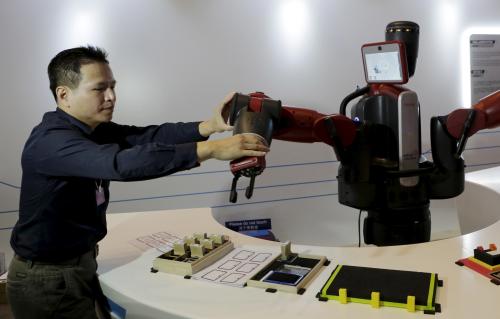The quest for national AI success has electrified the world—at last count, 44 countries have entered the race by creating their own national AI strategic plan. While the inclusion of countries like China, India, and the U.S. are expected, unexpected countries, including Uganda, Armenia, and Latvia, have also drafted national plans in hopes of realizing the promise. Our earlier posts, entitled “How different countries view artificial intelligence” and “Analyzing artificial intelligence plans in 34 countries” detailed how countries are approaching national AI plans, as well as how to interpret those plans. In this piece, we go a step further by examining indicators of future AI needs.
Evaluating fulfillment through factor analysis
Clearly, having a national AI plan is a necessary but not sufficient condition to achieve the goals of the various AI plans circulating around the world; 44 countries currently have such plans. In previous posts, we noted how AI plans were largely aspirational, and that moving from this aspiration to successful implementation required substantial public-private investments and efforts.
In order to analyze the implementation to-date of countries’ national AI objectives, we assembled a country-level dataset containing: the number and size of supercomputers in the country as a measure of technological infrastructure, the amount of public and private spending on AI initiatives, the number of AI startups in the country, the number of AI patents and conference papers the country’s scholars produced, and the number of people with STEM backgrounds in the country. Taken together, these elements provide valuable insights as to how far along a country is in implementing its plan.
As analyzing each of the data elements individually presented some data challenges, we conducted a factor analysis to determine if there was a logical grouping of the data elements. Factor analysis reveals the underlying structure of data; that is, the technique mathematically determines how many groups (or factors) of data exist by analyzing which data elements are most closely related to other elements.
Given that our data included five distinct dimensions (i.e., technology infrastructure, AI startups, spending, patents and conference papers, and people), we expected that five factors would emerge, particularly since the dimensions appear to be relatively separate and distinct. But the data showed otherwise. In all, this factor analysis revealed all of the data elements fall under two factors—people-related and technology-related.
The first factor is the set of AI hiring, STEM graduates, and technology skill penetration data points, which are all associated with the people side of AI. Without qualified people, AI implementations are unlikely to be effective.
The second factor is comprised of all the non-people data elements of AI, which include computing power, AI startups, investment, conference and journal papers, and AI patent submission data points. In looking at these data elements, we realized that all of the data elements in this factor were technology-related, either from a hardware or a thought-leadership standpoint.
Given these findings, we can treat the data as containing two distinct categories: people and technology. Figure 1 shows where a select set of countries sit along these dimensions.

Interpretation of Relative Positions
The countries that are in the upper right-hand corner we dub “Leaders;“ they have both the people (factor 1) and the technology (factor 2) to meet their goals. Countries in the lower right quadrant we dub “Technically Prepared,” and because they are higher on the technology dimensions (factor 2) but lower on the people dimensions (factor 1). Those countries in the upper left quadrant we dub the “People Prepared,” and largely due to their factors higher on the people dimension (factor 1), but lower on the technology dimension (factor 2). The final quadrant—the lower left quadrant—we dub the “Aspirational” quadrant since those countries have not yet substantially moved forward in either the people or technology dimension (factor 1 and 2 respectively) in achieving their national AI strategy.
China
China is unmistakably closer to achieving its national AI strategy goals. It is both a leader in the technical dimension and a leader in the people dimension. Of note is that, while China is strongly positioned in both dimensions, it is not highest in either dimension; the U.S. is higher in the technical dimension, and India, Singapore, and Germany are all higher on the people dimension. Given the population of China and its overall investment in AI-related spending, it is not surprising that China has an early and commanding lead over other countries.
United States
The U.S., while a leader in the technology dimension, particularly in the sub-dimensions of investments and patents, ranks a relatively dismal 15th place after such countries as Russia, Portugal, and Sweden in the people dimension. This is especially clear in the sub-dimension of STEM graduates, where it ranks near the bottom. While the vast U.S. spending advantage has given it an early lead in the technology dimensions, we suspect that the overall lack of STEM-qualified individuals is likely to significantly constrain the U.S. in achieving its strategic goals in the future.
India
By contrast, India holds a small but measurable lead over other countries in the people dimension, but is noticeably lagging in the technology dimension, particularly in the investment sub-dimension. This is not surprising, as India has long been known for its education prowess but has not invested equally with leaders in the technology dimension.
Our focus on China, the U.S., and India is not to suggest that these are the only countries that can achieve their national AI objectives. Other countries, notably South Korea, Germany, and the United Kingdom are just outside of top positions, and, by virtue of generally being well-balanced between the people and the technology dimensions, have an excellent chance to close the gap
Next Steps
At present, China, the U.S., and India are leading the way in implementing national AI plans. Yet China has already hit on a balanced strategy that has thus far eluded the U.S. and India. This suggests that China needs to merely continue its strategy. However, strategy refinement is necessary for the U.S. and India to keep pace. These leaders are closely followed by South Korea, Germany, and the United Kingdom.
In future posts, we will dive deeper into both the people and technology dimensions, and will dissect specific shortfalls for each country, as well as what can be done to address these shortfalls. Anything short of a substantial national commitment to AI achievement is likely to relegate the country to the status of a second-tier player in the space. If the U.S. wants to dominate this space, it needs to improve the people dimension of technology innovation and make sure it has the STEM graduates required to push its AI innovation to new heights.










Commentary
Winners and losers in the fulfillment of national artificial intelligence aspirations
October 21, 2021